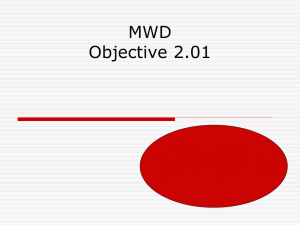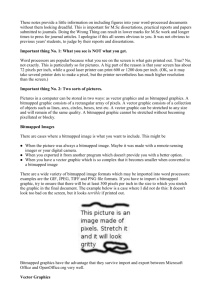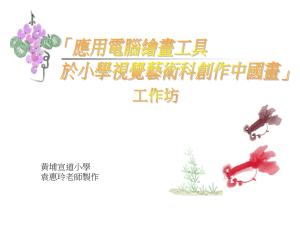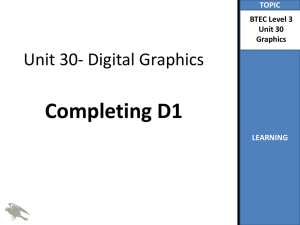Document
advertisement
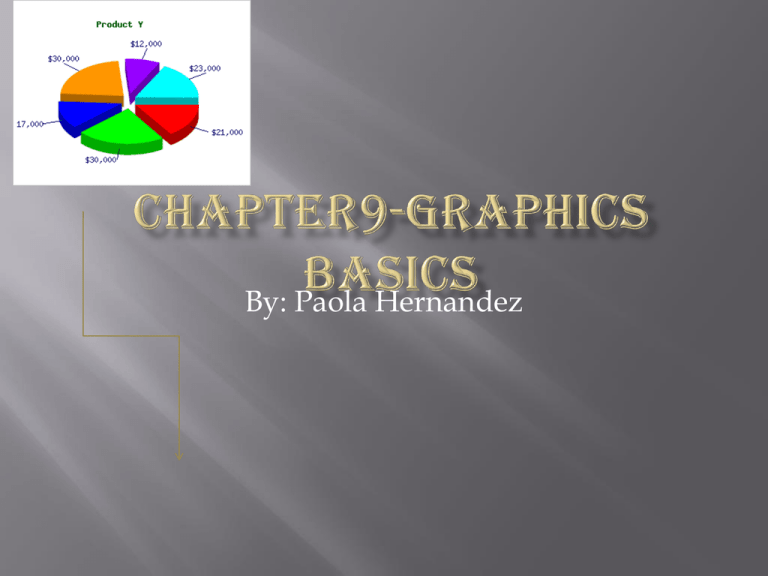
By: Paola Hernandez Chapter 9 Overview Lesson 9–1 Graphics and Their Uses Lesson 9–2 Exploring Graphics Programs Lesson 9–3 Working With Graphics Chapter Review and Assessment In day-to-day speech, people use the word graphic to refer to any visual image or object. A family photo, a road map, and a stick figure drawn on a chalkboard are all examples of graphics. When people talk about a computer graphic, they usually are referring to an image. Images include drawings, painted backgrounds, and photographs. Computer graphics can be displayed in a variety of ways. They can appear on the screen as a background, or they can be placed into a document to add color and information. Thus, in the broadest sense of the term, computer graphic could refer to anything that can be seen on the computer screen. Graphic- anything that can be seen on a computer’s screen grafico- todo lo que se ve en una pantalla de computadora bitmapped graphic- an image formed by a p attern of dots gráfico de mapa de bits- imagen formada mediante un patrón de puntos Pixel- a single point in a bitmapped graphic Pixel- punto individual de un gráfico de mapa de bits vector graphic- an image that is created using paths or lines gráfico vectorial-imagen que se crea mediante trayectorias o líneas paint program- the basic program for working with a bitmapped image programa de pintura-programa básico para trabajar con imágenes de mapa de bits Resolution- for a bitmapped image, the number of pixels in a certain section of the image Resolución- en el caso de una imagen de mapa de bits, el número de pixeles que hay en cierta sección de la imagen draw program- a program used to create and edit vector images programa de dibujo- programa que sirve para elaborar y editar imágenes vectoriales image editor- an advanced paint program that edits bitmapped images editor de imágenes- programa de pintura avanzado que edita imágenes de mapa de bits I. how do the bitmapped and vector graphics differ? II. If you want to enlarge a graphic to three times its size, should you start with a bitmapped or a vector image? Why? 1) Complete the following spider map showing the functions of paint programs, draw programs, and image editors When talking about computers, to what does the term “graphic” refer? A. pictures B. anishing that can be seen on the computer screen C.the desktop D.the screen Which type of graphic is formed by a pattern of dots? A. pixels B.a vector graphic C.a bitmapped graphic D.picture element Encapsulated PostScript (EPS) is an example of a(n)— A. file format B.image C.bitmap D.icon There are hundreds of different uses for computer graphics. However, graphics fall into only two categories: bitmapped graphics vector graphics Bitmapped Graphics A bitmapped graphic, or bitmap, is an image formed by a pattern of dots. Imagine a sheet of graph paper with each of its squares filled in with a certain color to make a picture. If seen from far enough away, the picture will look clear, and the squares won’t be noticed. But up close, you can see the individual squares of the graph paper. Bitmapped graphics are composed of tiny dots of different colors. Each single point in the image is a pixel, short for “picture element.” The smaller the pixels in the image, the smoother it will look. The more colors in the image, the brighter and sharper the image will look. Different programs allow you to create, edit, and view different graphic file types. Choosing the right program depends on which type of graphic you are working with and what your needs are. Paint Programs A paint program allows you to create a new bitmapped image. Paint programs also allow you to open a bitmapped image, view it on-screen, and make changes to it. Draw Programs A program that allows you to create and edit vector images is called a draw program. Since draw programs focus on vector images, they make editing easy. You can change the size of an image or add color to it. Basic draw programs, such as the one in Microsoft Word, allow you to perform simple drawing tasks. More complex programs, such as Adobe® Illustrator® and CorelDRAW®, allow you to do more but require more time to learn. Some common bitmapped file formats include: Graphics Interchange Format (GIF) Joint Photographic Experts Group (JPG) Portable Network Graphics (PNG) Windows Bitmap (BMP) Some formats are used for images on Web pages, while others are used for icons and images in the operating system. These same abbreviations are used as the file extensions. A file ending in .gif, for example, is in the GIF file format. Vector Graphics A vector graphic is an image that is created using paths or lines. A vector image tells the computer where a line starts and where it ends. It allows the computer to figure out how to connect the two points. The lines can form shapes, which may be filled with a color or pattern. Encapsulated PostScript, or EPS, is one of several formats commonly used for vector art. EPS files contain the information that a printer needs in order to print a graphic correctly. The information is combined with a small sketch of what the graphic should look like. The sketch inside an EPS file allows you to preview an image on-screen. This way, you can be sure the image is correct before printing it Two basic qualities affect how every bitmapped image will appear. Size, the height and width of the graphic, is normally measured either in pixels or in inches. Resolution tells how many pixels are in a certain piece of an image. Resolution also determines the quality of the computer image. Resolution is usually measured in dots per inch, or dpi. An image that is 1 inch square at 72 dpi will contain a total of 5,184 pixels (72 × 72). Generally, the higher the resolution, the sharper the image will look. Vector graphics are created using lines or paths rather than pixels. Thus, the number of dots per inch is not a concern when changing the size of vector graphics. If a bitmapped image is enlarged to twice its normal size, it will look fuzzy and jagged. A vector image can be enlarged to any size and keep its quality Workspace- the blank white area where the graphic will be worked on in a paint or draw program área de trabajo- área blanca vacía donde se trabaja sobre un gráfico en un programa de pintura o dibujo color palette- a display of options in a paint or draw program that allows the user to choose the color a tool will place in an image paleta de colores- representación de las opciones de un programa de pintura o dibujo, que permite al usuario elegir el color que una herramienta aplicará a una imagenes Eyedropper- a tool that picks up and works with a specific color from an image Gotero- herramienta que toma un color específico de una imagen para trabajar con él Selection tool- a program tool that can select a portion of an image to be moved, enlarged, or edited herramienta de selección- herramienta de programa que selecciona una parte de una imagen para desplazarla, ampliarla o editarla graphics tablet- a piece of hardware used for drawing tableta para gráficos- elemento de hardware que sirve para dibujar Stylus- a pointing device used for drawing on a graphics tablet Púa- dispositivo apuntador que sirve para dibujar sobre una tableta de gráficos Paint and draw programs vary from one to another, but most include a workspace, toolbars, and color palettes. Workspace Most of the screen is devoted to the workspace, the blank, white area which contains the graphic. This area is sometimes called the drawing area Toolbars A toolbar is a bar across the top or down the side of a window. It contains icons that link to the program’s tools. By clicking an icon, you can create, edit, add, or remove information within the graphic. Toolbars usually appear, or are docked, on the edges of the screen. They also can be moved around, or floated, to fit your preferences. Color Palettes The display of color options in paint and draw programs is called the color palette. These options allow you to choose colors for an image. Most programs also allow you to change the color palette. In paint programs, the following tools are used to place and remove color in the workspace Pencil The Pencil tool is used for freehand drawing. Clicking and dragging this tool across the workspace leaves a trail of the selected color. This tool is used to draw fine details but only the color or thickness of the line drawn can be changed. Brush The Brush tool works like the Pencil tool, but it makes a broader stroke of color. Often, the shape of the brush can be changed to create different shapes of colors. For instance, the brush can be large and square or small and circular Line and Shape The Line tool allows you to draw a line and use the toolbar to change its color and width. Various shapes, such as rectangles and ovals, also can be drawn using tools on the toolbar. Shape tools allow you to create shapes in three different forms: Outline, Filled With Outline, and Filled Without Outline. Eyedropper The Eyedropper tool allows you to work with a specific color from an image. You place the eyedropper over the desired color in an image and click. That color becomes the selected color and can be used elsewhere in the image. Eraser The Eraser tool removes color from an image. It is used by clicking the tool and dragging the eraser across the image. The area touched with the eraser becomes the background color. A variety of different input tools allow you to work easily with a graphics program. A mouse is used to select part of an image or to activate tools on the toolbar. By dragging ,releasing, or double- clicking the mouse, a tool’s function is performed A graphics tablet is a piece of hardware used for drawing. The user move4s a stylus, or pointing device, over the drawing surface. The tablet senses the movement of the stylus and moves the cursor on screen The tools in paint and draw programs have many uses. As you might expect, they often are used by newspaper and magazine publishers. What you might not expect is that students your age are using them, too. For example, at Centennial Middle School in Boulder, Colorado, students publish an online newspaper called The Vocal Point. To create and edit the images in the newspaper, students rely on graphics programs. Import- to bring information into a program from another program Importar- traer información a un programa desde otro programa Export- to format data so it can be used in another application Exportar- dar formato a los datos para que se puedan usar en otra aplicación Group- to combine separate vector images into one image Agrupar- combinar imágenes vectoriales individuales en una sola imagen DEFINITION FOR UNGROUP & DESGRUPAR Ungroup- to separate combined vector images into individual images Desagrupar- separar imágenes vectoriales combinadas en imágenes individuales DEFINITION FOE LAYER& DISPONER Layer- to stack parts of a bitmapped image on top of another level disponer en capasapilar partes de una imagen de mapa de bits sobre otro nivel clip art- a graphic that has already been created for use by others arte prediseñado-gráfico previamente elaborado para uso de otras personas Trace- to convert pixels into lines Trazar- convertir pixeles en líneas Adding Effects to Graphics To create a new graphic, start with a blank workspace. If you are creating the graphic in a paint program, use the paint tools to add color and form to the image. If you are creating the graphic in a draw program, use the Line and Shape tools to add information to the image. Special effects can be used to modify an image. Flipping an image turns it upside down. Mirroring the image makes it flip from left to right, as if it were being viewed in a mirror. Stretching makes the image appear longer in one direction than the other, as if it were drawn on a sheet of rubber that was stretched out. Skewing tilts the image horizontally or vertically. Inverting reverses the colors in the graphic. In a black-and-white graphic, all the white dots will turn black, and all the black will turn white. In a color graphic, each color will change to its “opposite” color. For example, yellow will become dark blue Combining Images Bringing information, such as a graphic, into a file from another file is called importing. Once imported, the image can then be modified or expanded. Exporting is when data is formatted so it can be used in another application. This means that the program you are working in must be able to translate its own language to the language another program understands. Different processes are used to combine vector images or bitmapped images. These processes are known as: grouping, for combining vector graphics layering, for combining bitmapped graphics Grouping Images In a vector graphic, different items can be placed together. Grouping is the process of combining separate images into one image. Once the images are grouped, they can be moved or resized as a single unit. To group images, select all of the desired items and then select the Group command. Ungrouping is the process of separating combined images into individual images. To ungroup an image, select a grouped image and then select the Ungroup command. Layering Images Bitmapped graphics use layers, or stacks of information, to create a graphic. A powerful process known as layering stacks each level of an image on top of another. Imagine three or four sheets of wax paper, each with a different part of a drawing. When all of them are stacked, the complete picture is visible. Although the layers are stacked, you can still edit them separately. Any changes you make only affect the layer you touch. The default layer is the background. You can add or delete layers as needed. The layer you’re working with is usually highlighted in a color. You can hide a layer you’re not using to see other parts of the image more easily. Working With Clip Art It is not always necessary to create an image from scratch. Instead, clip art—artwork that has already been created that you can download—can be used as a starting point. Bitmapped Clip Art Clip art in a bitmapped format (such as GIF, JPG, or PNG) can be imported into a paint document. The art then can be edited like any other bitmapped graphic. Vector Clip Art Vector art can be imported in a draw program and modified. If the image is complex, it can be ungrouped. Its individual parts can then be edited or moved.
